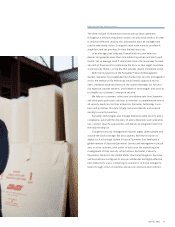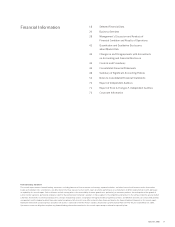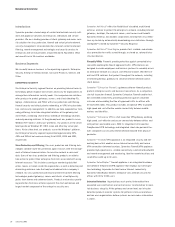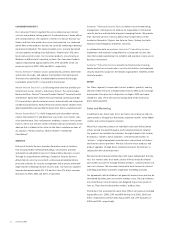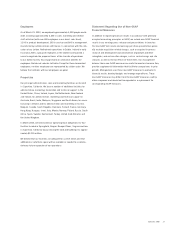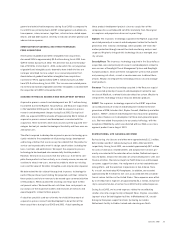Symantec 2003 Annual Report Download - page 27
Download and view the complete annual report
Please find page 27 of the 2003 Symantec annual report below. You can navigate through the pages in the report by either clicking on the pages listed below, or by using the keyword search tool below to find specific information within the annual report.
Symantec 2003 25
Product Development, Partnerships, Investments
and Acquisitions
We use a multiple product sourcing strategy that includes:
•internal development;
•licensing from third parties;
•investment in companies; and
•acquisitions of technologies, product lines or companies.
We develop software products that are designed to operate on a variety
of operating systems. We typically develop new products and enhance-
ments of existing products through focused product development
groups. Each product development group is responsible for its own
design, development, documentation and quality assurance. Our
research and development expenditures for each of the last three years
are further discussed under “Management’s Discussion and Analysis
of Financial Condition and Results of Operations – Research and
Development Expenses.”
Independent contractors are used for aspects of the product develop-
ment process. In addition, elements of some of our products are
licensed from third parties.
We invest in companies with emerging technologies and companies that
promote the sale and use of our products and services. These invest-
ments are made in lieu of an acquisition when timing is inappropriate or
when the business models and sectors fall out of our strategic require-
ments. We pursue investments which we believe will be complementary
and can enhance both financial returns and market growth.
We use strategic acquisitions as necessary to provide certain technol-
ogy, people and products for our overall product and services strategy.
We consider both timeliness to market and potential market share
growth when evaluating acquisitions of technologies, product lines or
companies. We have completed a number of acquisitions of technolo-
gies, companies and products in the past, and have also disposed of
technologies and products. We may acquire and/or dispose of other
technologies, companies and products in the future.
Competition
Our markets are intensely competitive and are subject to rapid changes
in technology. They are influenced by the constant change in Internet
security threats and the strategic direction of major software and oper-
ating system providers, network equipment and computer hardware
manufacturers, Internet service providers, application service providers
and key application software vendors. Our competitiveness depends
on our ability to deliver products that meet our customers’ needs by
enhancing our existing solutions and services and offering reliable, scal-
able and standardized new solutions on a timely basis. We have limited
resources, and as a result, we must deploy our available resources
thoughtfully. The principal competitive factors in our Enterprise Security
and Administration and Consumer Products segments are quality,
employment of the most advanced technology, time to market, price,
reputation, financial stability, breadth of product offerings, customer
support, brand recognition, and sales and marketing teams. In our
Services segment, the principal competitive factors include technical
capability, customer responsiveness, price, ability to attract and retain
talented and experienced personnel, financial stability, and reputation
within the industry.
In the enterprise security and administration market, we compete
against many companies who offer competing products to our technol-
ogy solutions and competing services to our response and support. In
the area of antivirus and filtering products, some of the companies we
compete against are Computer Associates, Network Associates, Sophos,
Trend Micro, and WebSense. In addition, Microsoft has announced its
intent to sell stand-alone antivirus products. In the area of firewall and
VPN, some of the companies we compete against are Checkpoint, Cisco,
NetScreen, SonicWALL and Watchguard. In the area of intrusion detec-
tion and security management, some of the companies we compete
against are Bindview, Internet Security Services and NetIQ. In the area
of remote management and cloning, some of the companies we compete
against are Altiris, Laplink and PowerQuest. In addition, we face indirect
or potential competition from operating system providers and network
equipment and computer hardware manufacturers, who provide or may
provide various security solutions and functions in their current and
future products. These competitors have significant advantages due to
their ability to influence or control the computing platforms, security
layers and network tiers on or in which security products operate. In
addition, these competitors generally have significantly greater finan-
cial, marketing or technological resources than we do. We believe that
our ability to compete in the enterprise security and administration
market going forward depends in part on providing simplified, solution-
oriented offerings that address multiple aspects of enterprise security.
Some of the companies that offer competing products to our Consumer
Products offerings include Internet Security Services, Kroll, Network
Associates, Norman, Panda, Trend Micro and ZoneLabs. With the recent
outbreaks of viruses and other Internet-based security threats, several
other companies have entered the market and may become significant
competitors in the future.
Our Enterprise Security Services compete with companies such as
Counterpane, IBM, Internet Security Services and Ubizen.
Price competition is intense with most of our products and services.
We expect price competition to continue to increase and become even
more significant in the future, which may reduce our profit margins.
We also face competition from a number of other products that offer
levels of functionality different from those offered by our products, or
that were designed for a somewhat different group of end-users than
those targeted by us. Microsoft has added security features to new ver-
sions of its operating system products that provide some of the same
functions offered in our products, and has recently announced the
acquisition of antivirus technology, which creates the possibility that it
will include antivirus functions in future versions of its operating system


